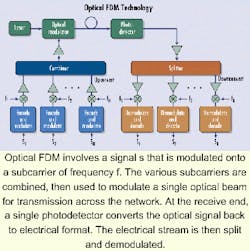Optical FDM technology nears commercialization
On the heels of optical code-division multiple access, another wireless technology is nearing its optical debut.Network equipment based on optical frequency-division multiplexing (FDM) should appear on the market by the first quarter of next year, opening the door to yet another complement to wavelength-division multiplexing (WDM).
Kestrel Solutions (Mountain View, CA) will incorporate the technology into its TalonMX optical add/drop multiplexer, which the company plans to target toward metropolitan-area-network applications. According to Meldon Gafner, Kestrel's chairman, and Dawn Hogh, vice president of marketing, optical FDM combines FDM, digital signal processing, and optical modulation (see Figure). Like the subcarrier multiplexing common to hybrid fiber/coax applications, optical FDM begins with an information stream that is modulated independently onto a subcarrier at an assigned frequency. Multiple subcarriers--each potentially carrying different kinds of traffic--are combined electronically; the resultant composite signal is used to modulate the light from a single laser transmitter. At the receive end, a single photodetector converts the optical signal back into an electrical signal. A sequence of frequency conversions and electronic filters separate the subcarriers into constituent signals.Since digital electronics only have to operate as fast as the channel rate of an individual subcarrier channel, standard RF silicon circuits can be used to perform signal processing. This approach contrasts to the necessity in high-speed time-division multiplexing systems of a digital clock rate that equals the aggregate transmission rate, which can require the use of more-expensive gallium arsenide circuits. The fact that no synchronization is necessary between channels means that each channel can be both protocol and rate independent.
Besides lower cost, optical FDM offers other advantages over conventional optical multiplexing schemes, Kestrel executives say. The optical FDM waveforms undergo 3R regeneration at each node, which simplifies network design. Kestrel has targeted a transmission distance of 70 km for the first release of the TalonMX, reports Hogh. The regeneration capability and the general properties of optical FDM mean that the technique should work with virtually any fiber, including older fiber types and dispersion-shifted fiber. Meanwhile, the fact that all the channels are converted to electrical signals at each node simplifies add/drop multiplexing via an electrical crossbar switch. Performance monitoring and fault isolation on each channel also become easier.
Optical FDM improves bandwidth efficiency as well, say Gafner and Hogh. A 10-Gbit/sec optical FDM waveform occupies less than the 20-GHz bandwidth common to OC-192 transmissions. The Kestrel representatives also point out that a 4-channel OC-48 multiplexer, operating at an aggressive 50-GHz channel spacing, would require 200 GHz of bandwidth to transmit the same amount of traffic. However, given the small spectrum of the optical FDM waveform, these waves could be integrated into a conventional dense WDM system to provide multiple channels of 10-Gbit/sec traffic with very tight channel spacings.

